初一英语外研社版 Module9 People and places 词句精讲精练
- 格式:doc
- 大小:57.00 KB
- 文档页数:7
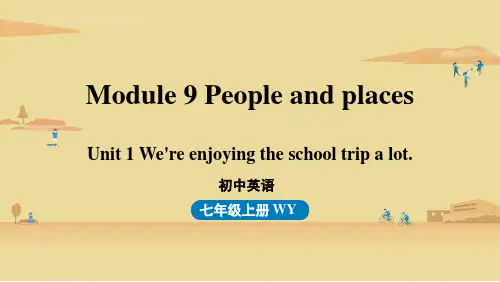

Module9 People and places一.重点短语1. have a good/great time玩得开心2. go to sleep 去睡觉3. call a friend 给朋友打电话4. drive a car 开车5. run for a bus 赶公共汽车6. study history 学习历史7. send ...to... 寄……给…… In8. start school开始上学9. wait for 等待,等候10. a few 一些;几个11. take some photos of拍一些……的照片12. by email通过电子邮件13. go back 回去14. stand in line站成一排15. take photos 拍照16.at this moment 在此时17. get off下(飞机、火车、公共汽车等)18.make notes做笔记19. have afternoon tea喝下午茶20. in the evening在晚上21. watch a film 看电影22. play games 玩游戏23. hot dog热狗(一种中间夹香肠的三明治)24. see friends看望朋友25. movie star 电影明星二.重点句式1. I'm standing on the Great Wall of China and talking to you.我正站在中国的长城上和你交谈。
2. They're on sale at the shop.商店里正在打折。
3. Daming is having lunch and lying in the sun.大明正躺在阳光下,吃着午饭。
4. We're enjoying the school trip a lot.我们这次学校旅游玩得非常开心。
5. Anyway, it's time to go back to school now.尽管如此,现在到回学校的时间了。
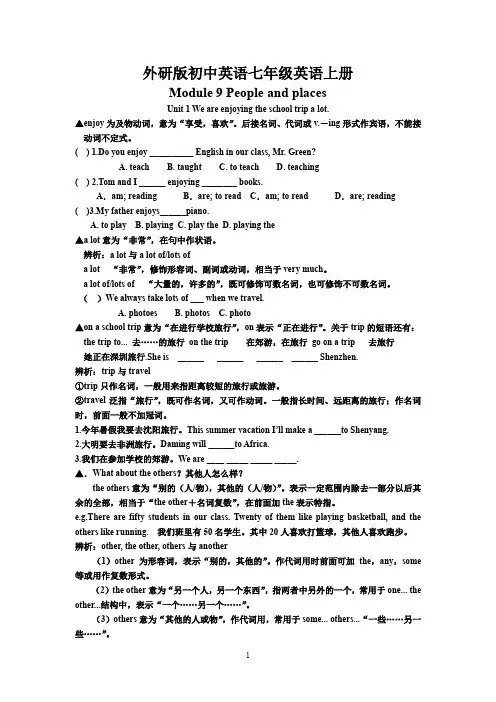
外研版初中英语七年级英语上册Module 9 People and placesUnit 1 We are enjoying the school trip a lot.▲enjoy为及物动词,意为“享受,喜欢”。
后接名词、代词或v.-ing形式作宾语,不能接动词不定式。
( ) 1.Do you enjoy __________ English in our class, Mr. Green?A. teachB. taughtC. to teachD. teaching( ) 2.Tom and I ______ enjoying ________ books.A.am; reading B.are; to read C.am; to read D.are; reading ( )3.My father enjoys______piano.A. to playB. playingC. play theD. playing the▲a lot意为“非常”,在句中作状语。
辨析:a lot与a lot of/lots ofa lot “非常”,修饰形容词、副词或动词,相当于very much。
a lot of/lots of “大量的,许多的”,既可修饰可数名词,也可修饰不可数名词。
()We always take lots of ___ when we travel.A. photoesB. photosC. photo▲on a school trip意为“在进行学校旅行”,on表示“正在进行”。
关于trip的短语还有:the trip to... 去……的旅行on the trip在郊游,在旅行go on a trip去旅行她正在深圳旅行.She is ______ ______ ______ ______ Shenzhen.辨析:trip与travel①trip只作名词,一般用来指距离较短的旅行或旅游。
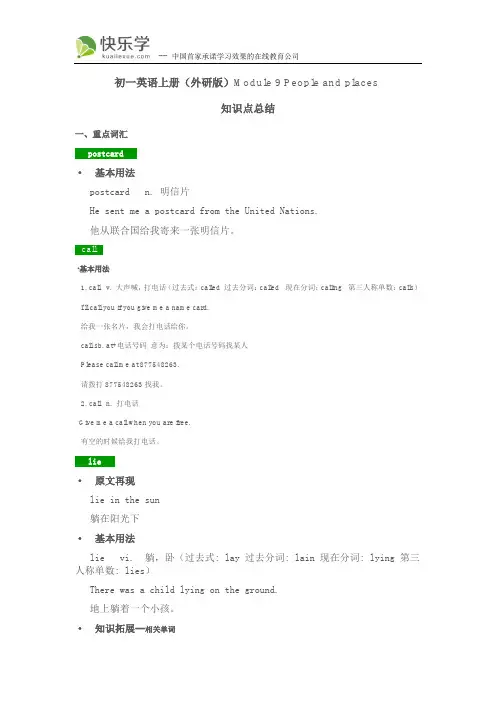
初一英语上册(外研版)Module 9 People and places知识点总结一、重点词汇postcard·基本用法postcard n. 明信片He sent me a postcard from the United Nations.他从联合国给我寄来一张明信片。
call·基本用法1. call v. 大声喊,打电话(过去式:called 过去分词:called 现在分词:calling 第三人称单数:calls)I'll call you if you give me a name card.给我一张名片,我会打电话给你。
call sb. at+电话号码意为:拨某个电话号码找某人Please call me at 877548263.请拨打877548263找我。
2. call n. 打电话Give me a call when you are free.有空的时候给我打电话。
lie·原文再现lie in the sun躺在阳光下·基本用法lie vi. 躺,卧(过去式: lay 过去分词: lain 现在分词: lying 第三人称单数: lies)There was a child lying on the ground.地上躺着一个小孩。
·知识拓展--相关单词1. lie n. 谎言, tell a lie 意为:撒谎I supposed it wrong to tell a lie.我认为说谎不对。
2. lie vi. 说谎,撒谎(过去式: lied 过去分词: lied 现在分词: lying 第三人称单数: lies)lie to sb 意为:向某人撒谎Don't lie to me.不要对我撒谎。
line·原文再现stand in line站成一排·基本用法line n. 线,行,排in line 意为:成一直线,成一排I had been standing in line for three hours.我已经排了3个小时的队。
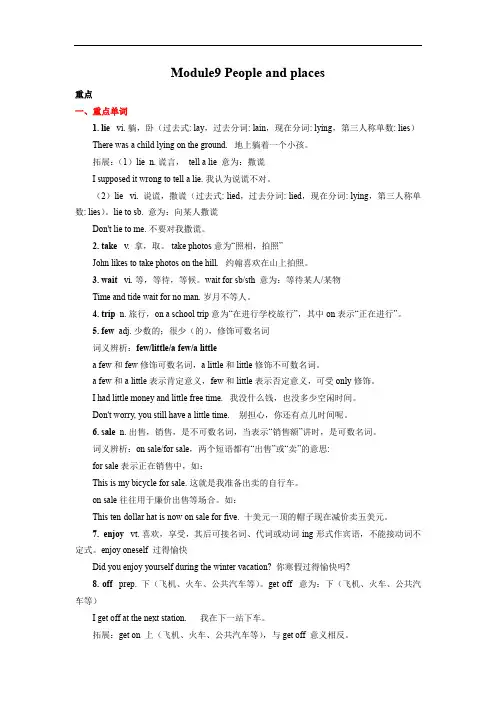
Module9 People and places重点一、重点单词1. lie vi.躺,卧(过去式: lay,过去分词: lain,现在分词: lying,第三人称单数: lies)There was a child lying on the ground.地上躺着一个小孩。
拓展:(1)lie n.谎言,tell a lie 意为:撒谎I supposed it wrong to tell a lie.我认为说谎不对。
(2)lie vi. 说谎,撒谎(过去式: lied,过去分词: lied,现在分词: lying,第三人称单数: lies)。
lie to sb. 意为:向某人撒谎Don't lie to me.不要对我撒谎。
2. take v. 拿,取。
take photos意为“照相,拍照”John likes to take photos on the hill.约翰喜欢在山上拍照。
3. wait vi.等,等待,等候。
wait for sb/sth 意为:等待某人/某物Time and tide wait for no man.岁月不等人。
4. trip n.旅行,on a school trip意为“在进行学校旅行”,其中on表示“正在进行”。
5. few adj.少数的;很少(的),修饰可数名词词义辨析:few/little/a few/a littlea few和few修饰可数名词,a little和little修饰不可数名词。
a few和a little表示肯定意义,few和little表示否定意义,可受only修饰。
I had little money and little free time.我没什么钱,也没多少空闲时间。
Don't worry, you still have a little time.别担心,你还有点儿时间呢。
6. sale n.出售,销售,是不可数名词,当表示“销售额”讲时,是可数名词。
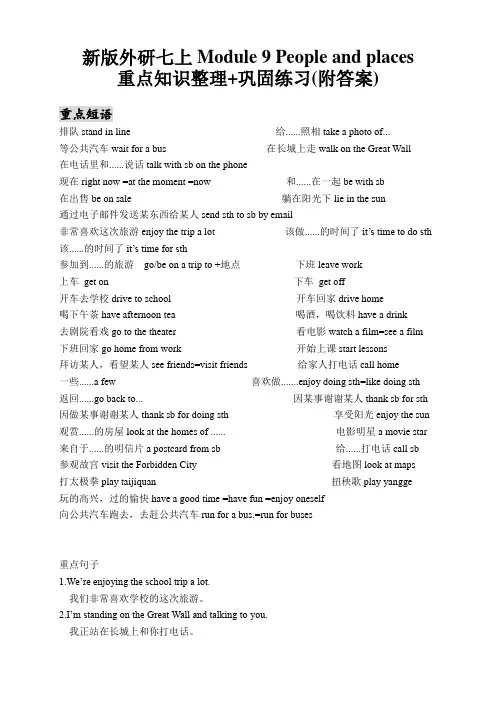
新版外研七上Module 9 People and places 重点知识整理+巩固练习(附答案)重点短语排队stand in line 给......照相take a photo of...等公共汽车wait for a bus 在长城上走walk on the Great Wall在电话里和......说话talk with sb on the phone现在right now =at the moment =now 和......在一起be with sb在出售be on sale 躺在阳光下lie in the sun通过电子邮件发送某东西给某人send sth to sb by email非常喜欢这次旅游enjoy the trip a lot 该做......的时间了it’s time to do sth 该......的时间了it’s time for sth参加到......的旅游go/be on a trip to +地点下班leave work上车get on 下车get off开车去学校drive to school 开车回家drive home喝下午茶have afternoon tea 喝酒,喝饮料have a drink去剧院看戏go to the theater 看电影watch a film=see a film 下班回家go home from work 开始上课start lessons拜访某人,看望某人see friends=visit friends 给家人打电话call home一些......a few 喜欢做.......enjoy doing sth=like doing sth返回......go back to... 因某事谢谢某人thank sb for sth 因做某事谢谢某人thank sb for doing sth 享受阳光enjoy the sun 观赏......的房屋look at the homes of ...... 电影明星a movie star 来自于......的明信片a postcard from sb 给......打电话call sb参观故宫visit the Forbidden City 看地图look at maps打太极拳play taijiquan 扭秧歌play yangge玩的高兴,过的愉快have a good time =have fun =enjoy oneself向公共汽车跑去,去赶公共汽车run for a bus.=run for buses重点句子1.We’re enjoying the school trip a lot.我们非常喜欢学校的这次旅游。
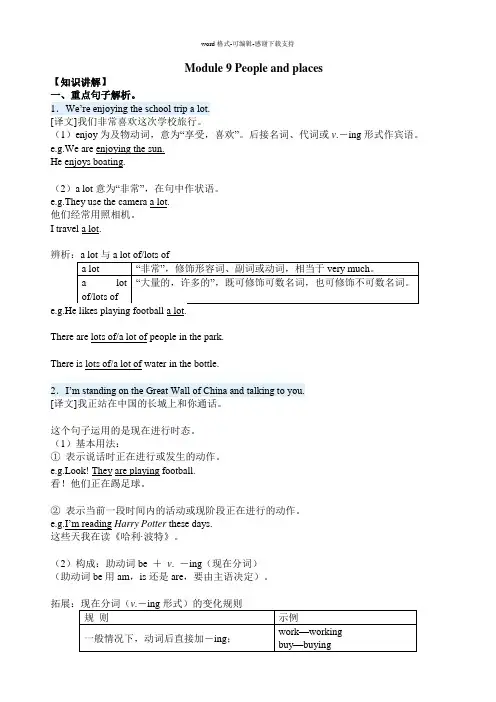
Module 9 People and places【知识讲解】一、重点句子解析。
1.We’re enjoying the school trip a lot.[译文]我们非常喜欢这次学校旅行。
(1)enjoy为及物动词,意为“享受,喜欢”。
后接名词、代词或v.-ing形式作宾语。
e.g.We are enjoying the sun.He enjoys boating.(2)a lot意为“非常”,在句中作状语。
e.g.They use the camera a lot.他们经常用照相机。
I travel a lot.2.I’m standing on the Great Wall of China and talking to you.[译文]我正站在中国的长城上和你通话。
这个句子运用的是现在进行时态。
(1)基本用法:①表示说话时正在进行或发生的动作。
e.g.Look! They are playing football.看!他们正在踢足球。
②表示当前一段时间内的活动或现阶段正在进行的动作。
e.g.I’m reading Harry Potter these days.这些天我在读《哈利·波特》。
(2)构成:助动词be +v. -ing(现在分词)(助动词be用am,is还是are,要由主语决定)。
注意:以ie结尾的动词变为现在分词时,要把ie变为y再加-ing。
如:die—dying,lie-lying,tie—tying等。
注意:表示位置移动的动词,如leave,move,go,come等也常用现在进行时表示动作将要发生,而不表示动作正在进行。
Next month my family is moving to Beijing.下个月我家就要搬到北京去了。
(“搬”的动作并非现在发生,而是在下个月发生)My aunt is leaving for Shanghai at eleven o’clock tomorrow morning.(4)常用于现在进行时的词与短语有:now(现在),at the/this moment(此刻),look(看),listen(听)等。
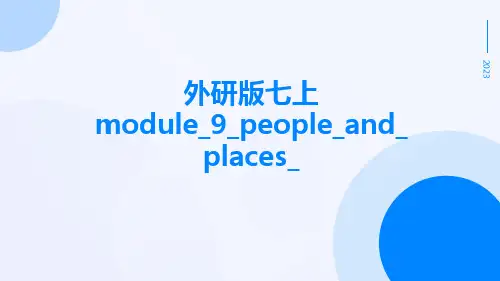
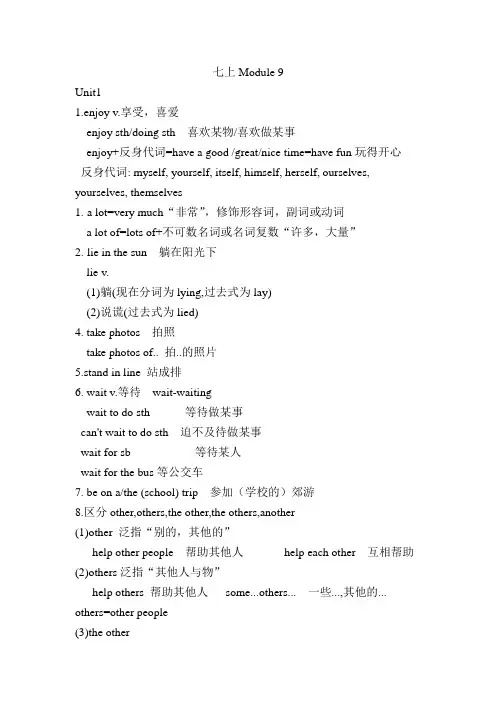
七上Module 9Unit11.enjoy v.享受,喜爱enjoy sth/doing sth 喜欢某物/喜欢做某事enjoy+反身代词=have a good /great/nice time=have fun玩得开心反身代词: myself, yourself, itself, himself, herself, ourselves, yourselves, themselves1.a lot=very much“非常”,修饰形容词,副词或动词a lot of=lots of+不可数名词或名词复数“许多,大量”2.lie in the sun 躺在阳光下lie v.(1)躺(现在分词为lying,过去式为lay)(2)说谎(过去式为lied)4. take photos 拍照take photos of.. 拍..的照片5.stand in line 站成排6. wait v.等待wait-waitingwait to do sth 等待做某事can't wait to do sth 迫不及待做某事wait for sb 等待某人wait for the bus等公交车7. be on a/the (school) trip 参加(学校的)郊游8.区分other,others,the other,the others,another(1)other 泛指“别的,其他的”help other people 帮助其他人help each other 互相帮助(2)others泛指“其他人与物”help others 帮助其他人some...others... 一些...,其他的... others=other people(3)the other①指两个人或物中的一个。
one..., the other... 一个...,另一个...,He has two daughters. One is a nurse, the other is a worker.他有两个女儿,-一个是护士,另一个是工人。
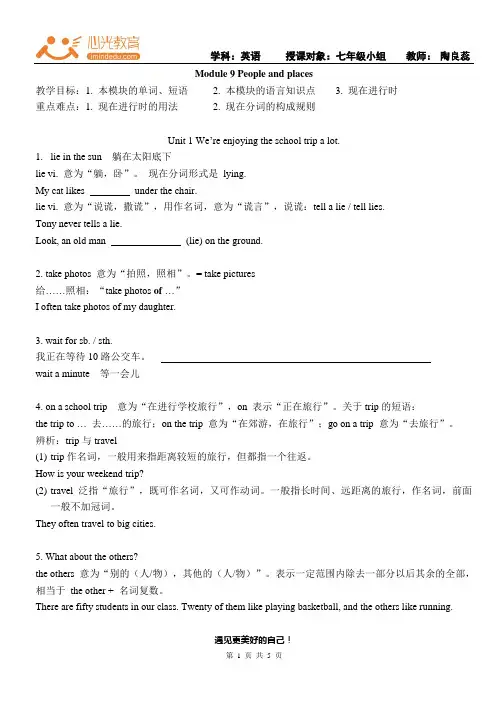
Module 9 People and places教学目标:1. 本模块的单词、短语 2. 本模块的语言知识点 3. 现在进行时重点难点:1. 现在进行时的用法 2. 现在分词的构成规则Unit 1 We’re enjoying the school trip a lot.1.lie in the sun 躺在太阳底下lie vi. 意为“躺,卧”。
现在分词形式是lying.My cat likes under the chair.lie vi. 意为“说谎,撒谎”,用作名词,意为“谎言”,说谎:tell a lie / tell lies.Tony never tells a lie.Look, an old man (lie) on the ground.2. take photos 意为“拍照,照相”。
= take pictures给……照相:“take photos of …”I often take photos of my daughter.3. wait for sb. / sth.我正在等待10路公交车。
wait a minute 等一会儿4. on a school trip 意为“在进行学校旅行”,on 表示“正在旅行”。
关于trip的短语:the trip to …去……的旅行;on the trip 意为“在郊游,在旅行”;go on a trip 意为“去旅行”。
辨析:trip与travel(1)trip作名词,一般用来指距离较短的旅行,但都指一个往返。
How is your weekend trip?(2)travel 泛指“旅行”,既可作名词,又可作动词。
一般指长时间、远距离的旅行,作名词,前面一般不加冠词。
They often travel to big cities.5. What about the others?the others 意为“别的(人/物),其他的(人/物)”。
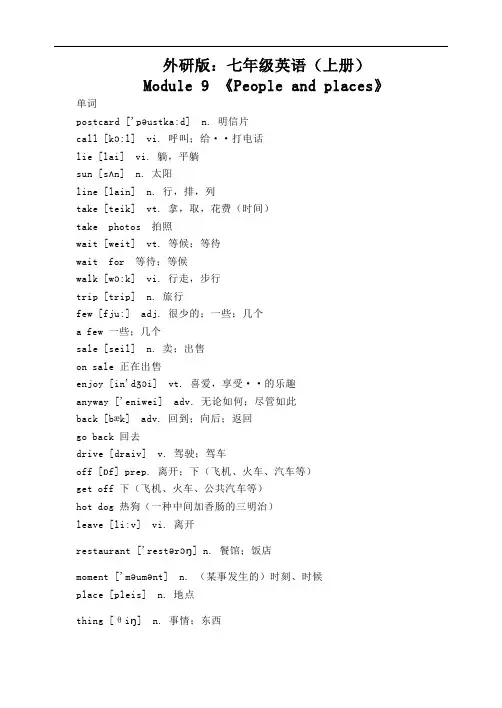
外研版:七年级英语(上册)Module 9 《People and places》单词postcard['pəustka:d]n.明信片call[kɔ:l]vi.呼叫;给··打电话lie[lai]vi.躺,平躺sun[sʌn]n.太阳line[lain]n.行,排,列take[teik]vt.拿,取,花费(时间)take photos拍照wait[weit]vt.等候;等待wait for等待;等候walk[wɔ:k]vi.行走,步行trip[trip]n.旅行few[fju:]adj.很少的;一些;几个a few一些;几个sale[seil]n.卖;出售on sale正在出售enjoy[in'dʒɔi]vt.喜爱,享受··的乐趣anyway['eniwei]adv.无论如何;尽管如此back[bæk]adv.回到;向后;返回go back回去drive[draiv]v.驾驶;驾车off[ɒf]prep.离开;下(飞机、火车、汽车等)get off下(飞机、火车、公共汽车等)hot dog热狗(一种中间加香肠的三明治)leave[li:v]vi.离开restaurant['restərɔŋ]n.餐馆;饭店moment['məumənt]n.(某事发生的)时刻、时候place[pleis]n.地点thing[θiŋ]n.事情;东西most[məust]adj.大部分的,多数的still[stil]adv.仍然;依旧star[stɑ:]n.星;明星;星状物run[rʌn]vi.跑;奔跑study['stʌdi]vt.学习;研究重点词组1. enjoy doing sth. 喜爱做某事2. enjoy oneself =have a good/great time 玩的开心3. a lot = very much 非常,很Thanks a lot. 非常感谢。
七年级英语(上)(外研版)Module 9:People and places·【易错题举例】【例1】:1.—Dave, where is our mom? I can't find her.—She lunch for us now.A. makesB. madeC. has madeD. is making【答案】D【解析】句意:——Dave, 我们的妈妈在哪里?我找不到她。
——她现在正在为我们做午饭。
根据时间副词now可知此处用现在进行时be doing,故选D。
【例2】:2.—Where are you going, Bob?—To go hiking. Eric _____for me at the school gate!A. waitB. waitsC. waitedD. is waiting【答案】D【解析】试题分析:句意:——鲍勃,你要去哪里?——去徒步旅行。
埃里克在校门口等我。
根据Where are you going可知此处询问他现在要去哪里,因此应是正在校门口等我,故用现在进行时is waiting,故选D。
【例3】:3.— Peter, where is your brother?— He his English homework.A. is doingB. doesC. will doD. did【答案】A【解析】试题分析:句意:——皮特,你的弟弟在哪?——他正在做英语作业。
根据题意可知用现在进行时,其结构是be doing的形式,主语是第三人称单数,谓语动词用is。
结合语境,故选A。
·【相似练习】【练习1】:4.—When _____ you _____ for Japan?—Tomorrow morning.A. do; leaveB. are; leavingC. will; leavingD. did; leave【答案】B【解析】试题分析:句意:你何时出发去日本?——明天上午。
外研社2011版七年级上册Module 9 People and placesUnit2 They’re waiting for buses or trains广西横县云表镇第一初级中学黄丽花教学目标1.能够读懂以现在进行时为主要语法项目的短文2.能够掌握本单元重要的词汇和短语3.能够仿写含有现在进行时等语法项目和反应日常生活信息的明信片4.了解世界不同地方人们的异同,拓宽文化视野教学内容1.学习本单元的重点词汇和短语:drive, leave, restaurant,place, thing,most , Get off, leave work, have dinner, watch film, play games.2.学习描述正在做某事的句子:People are leaving work and are....They are waiting for ...Some are.......重点难点重点:1.能够掌握重点的词汇与语法2.能够读懂以现在进行时为主要语法项目的短文难点:1.能够掌握现在进行时态结构及现在分词的构成规则2.能够描述自己或他人正在做得事情3.能够仿写明信片教学思路在本单元的教学活动中,教师充分利用黑板、投影、多媒体等辅助教学,来增加教学的直观性和趣味性。
在阅读活动设计中遵循主体性原则、生活化原则、拓展延伸原则。
教师组织以学生为中心的课堂活动,激发学生的学习热情和学习兴趣,给学生提供了各种运用英语的情景。
在一步步地巩固强化所学单词、短语和句型等语言知识基础上,通过拓展性阅读语篇和仿写明信片,给学生足够的语言活动创造空间,秀出学生的语言学习效果。
教学准备多媒体,黑板,投影仪,教学课件,单机版网络教材光盘等教学过程Step1.Revision把学生分成两大组,分角色背诵上一单元所学的对话T: Hello,boys and girls.Let’s being our class.Since we have learned Unit 1 We are enjoying the school trip a lot ,so let’s do some revision as usual .Can you recite the text now?Ss: Yes!T: OK! Let’s recite the text in the different roles! Group 1 and Group2 ,would you like to be Betty?And Group 3 and Group 4 would you like to be Mum? Ss: Yes!T: And the first sentence is for me.Hi,Mum.Ss: ...(the students begin reciting the text in different roles)活动设计意图:背诵能够帮助思考,而思考也需要借助于背诵。
Module9 People and places词句精讲精练词汇精讲1. talktalk意为“谈话”,当talk作此意讲时,不强调内容,一般指说的动作,其后常接介词to 和with,表示“与……谈话”;接介词about时表示“谈论……”。
例如:Jimmy and Bill often talk about computer games. 吉姆和比尔经常谈论电脑游戏。
Mary is talking with Mr. Green in English. 玛丽正在用英语和格林先生交谈。
拓展:speak、say和tell1)speak一词强调说话的能力、对象和方式。
用作及物动词时后接表示语言的名词作宾语;用作不及物动词时,后接介词to,表示“与……讲话”,一般用于打电话用语中或较正式的情况下。
例如:They can speak Chinese. 他们会说中文。
May I speak to Mr. Black? 请问,我能和布莱克先生讲话吗?2)say用作及物动词,强调说的内容。
若指“对某人说”用say to sb.来表示。
例如:Can you say it in English? 你能用英语说它吗?I couldn’t think of anything to say to him. 我想不出有什么话要对他说。
3) tell经常作及物动词,意为“讲述,告诉”,后常接双宾语,侧重把一件事情传达给别人。
常用结构是tell sb. to do sth. 意为“告诉某人做某事”,其否定形式为tell sb. not to do sth.,意为“告诉某人不要做某事”,tell sb. about sth. 意为“告诉某人关于某事”。
例如:My mother tells me to get up early. 我妈妈告诉我早点起床。
2. the othersthe others表示一定范围内除去一部分以后其余的部分,特指已知的人或物中“除……之外其余的全部”,相当于the other+名词复数,在前面加the表示特指。
Some girls are reading, the others are writing. 一些女孩在读书,其余的女孩在写作。
(the others相当于the other girls)There are 22 boys. Ten of them are playing football, the others are playing basketball. 有22个男孩,十个在踢足球,其他的在打篮球。
拓展: other / the other / others / another的区别:1) other为形容词“别的,其他的”。
作代词用时前面可加the / any /some等或用作复数。
例如:He is taller than any other brothers. 他比其他几个兄弟都高。
2) the other意为“另一个人,另一个东西”,指两者中另外的一个。
例如:I have two books. One is an English book, the other is a Chinese book.我有两本书,一本是英语书,另一本是语文书。
3) others意为“其他的人或物”,作代词用。
例如:You should think of others. 你应该想想别人。
4) another作形容词,意为“另外的,别的”,只可修饰单数名词;作代词,意为“另一个,再一个”,指三者或三者以上中的任何一个。
例如:Here comes another bus. 又来了一辆公共汽车。
3. in the sunin the sun意为“在阳光下”,常用作状语。
如:My grandpa likes lying in the sun. 我爷爷喜欢躺在阳光下。
拓展:1) under the sun 意为“世界上,天底下”,相当于in the world,on the earth。
常用作后置定语,强调所修饰的对象。
例如:I think you are the best person under the sun. Thank you for your great help.我想你是天底下最好的人,谢谢你极大的帮助。
2) 与in the sun类似的短语还有:in the light在灯光下;in the rain在雨中4. wait for“wait for”意为“等待”;“wait for sb. / sth.”意为“等待某人或某物”。
例如:My friend is waiting for me. 我朋友正在等我。
拓展:wait to do sth.等待去干某事,例如:They are waiting to see their teachers. 他们正等着去看老师。
5. get off“get off”意为“下车(船)”,其反义词是“get on”,意为“上车(船)”。
例如:Don’t get off the bus until it stops. 车没停稳之前不要下车。
注意:上下小汽车不用“get on/off”,而用“get into / out of ”。
例如:She got into her father’s car. 她上了她爸爸的小汽车。
6. a few&a little1)a few意为“一些,有几个”,后面接可数名词的复数形式,表示肯定含义。
few意为“很少,几乎没有”,后接可数名词复数形式,表示否定含义。
例如:There are a few apples in the fridge. 冰箱里有几个苹果。
He is new here. So he has few friends.他是这里新来的,所以几乎没有朋友。
2)a little“少许,有点”,后接不可数名词,表示肯定含义。
little“一点,几乎没有”,后接不可数名词,表示否定含义。
例如:I have learned English for one year. So I know a little English.我学英语一年了,所以懂得一点英语。
Hurry up, there is little time left. 快点,几乎没有时间了。
7. salesale是名词,它的意思是“卖,出售”,与介词on或者for搭配。
on sale表示“正在出售/(特价),销售”。
例如:There are some books on sale in this book shop. 这个书店正在促销一些书。
拓展:for sale表示“待售”。
例如:The house is for sale. 这个房子待售。
sale的动词形式是sell。
例如:We sell all our clothes at very good price.我们所有的衣服都以非常好的价格出售。
8. take1)take意为“拿,取,花费”。
当“花费”讲时用在固定句式“It takes sb. some time to do sth.”中,意为“花费某人多长时间做某事”;例如:It took me half an hour to finish the work. 完成这项工作花了我半小时。
2)take当“拿,取讲时”,意为“把某物从说话处带走”,和“bring”相反。
例如:Please take a photo of your family to school tomorrow.请明天带张全家福到学校来。
3)“take photos”是固定词组,意为“拍照”。
“photos”的前面可以加量词表示拍照的数量。
例如:We are taking lots of photos on the Great Wall.我们正在长城上拍很多的照片。
9. anywayanyway 副词,意为“无论如何”,常用在句首或者句末,用于句首时后面通常加逗号。
例如:He may not like my visit, but I will go and see him anyway.他也许不喜欢我去拜访他,但无论如何我还是要去看他。
Anyway, we all love you.无论如何,我们都爱你。
10. by emailby email意为“通过电子邮件”。
介词“by”可以表示通过某种手段或者方法。
后面可以跟名词也可以跟动词,跟动词时要用动词的动名词(-ing)形式。
例如:Some students learn English by computer.一些学生通过电脑学习英语。
I learn English by reading English stories.我通过读英文故事学英语。
词汇精练Ⅰ. 英汉互译。
1. 躺在阳光下________2. get off________3. 排队________4. anyway_______5. a few minutes ________6. 讨论________7. have a great time________8. write postcards_______ 9. school trip________ 10. go back________Ⅱ. 根据句意,完成所缺单词,首字母已给出。
1. In winter, old people like going out to e________ the sun.2. Do you know what time it is in London at this m________?3. You can send me some pictures by e_______.4. After school, some students are going home, o_______ are cleaning the classroom.5. School is over. The students are l________ school and going home.6. Many people are w_______ for the bus at the bus station.7. Let’s eat something in the nearest r________.8. My father d______ to his office every day.9. The house is on s______ now.10. The children are t________ a lot of photos on the Great Wall.Ⅲ. 用所给词的适当形式填空。